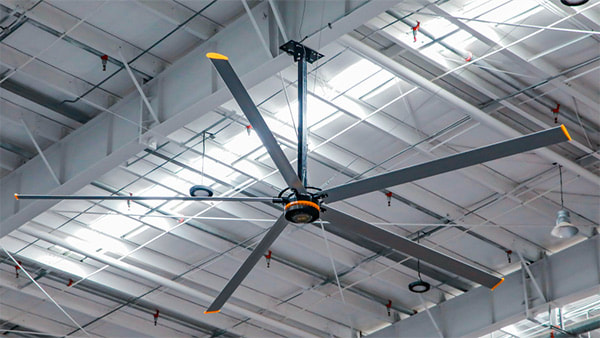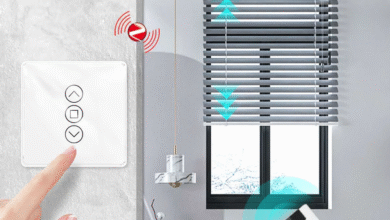Industrial Ceiling Fans: Powering Performance in Large-Scale Environments

Introduction
Industrial ceiling fans are powerful, robust systems designed to accommodate the demanding conditions of large indoor spaces such as factories, warehouses, gymnasiums, workshops, agricultural barns, and commercial venues. Unlike residential ceiling fans, they deliver high-volume airflow over vast areas while operating efficiently and reliably. In settings where temperature control, air circulation, and worker comfort must be maintained under heavy usage and sometimes harsh environments, industrial ceiling fans are indispensable technological allies. This article explores their design, operational benefits, applications, selection criteria, installation practices, and emerging trends, offering a comprehensive perspective with non-stop flow and well-structured headings to enhance readability and coherence.
What Defines an Industrial Ceiling Fan
Industrial ceiling fans are characterized by their large blade diameters—often ranging from 72 inches to 24 feet in high-volume, low-speed (HVLS) configurations—and robust motor systems designed for continuous operation in challenging conditions. These fans are often constructed from heavy-duty materials such as anodized aluminum, stainless steel, or reinforced composites to resist corrosion, withstand airborne particulates, and survive moisture or dust exposure in homes of industry. Their motors are typically brushless direct current (BLDC) or three-phase induction types, providing high torque, energy efficiency, and extended operational lifespans. Industrial fans operate at lower revolutions per minute compared to residential fans, delivering substantial airflow while minimizing noise and reducing wear.
Blade Design and Aerodynamics
The blades of industrial ceiling fans are engineered to produce vast volumes of air with minimal turbulence. Blades often incorporate swept-back leading edges, vertical arcs, or airfoil-inspired contours that facilitate laminar flow. In HVLS models, larger blade spans generate massive slow-moving air columns that gently circulate the room, eliminating hot or cold pockets and improving overall thermal balance. Materials are chosen to minimize structural flexing and vibration while ensuring consistent airflow across the entire coverage area. These aerodynamic designs are critical for performance, safety, and energy efficiency.
Motor Technology and Controls
High-efficiency motors in industrial fans are permanently lubricated, sealed against dust and moisture, and equipped with thermal overload protection. BLDC motors reduce energy usage and deliver quiet operation, while three-phase induction motors offer ruggedness in heavy-duty applications. Advanced fans incorporate smart controls—variable frequency drives, wireless remote systems, timed operation, and integration with building automation systems. Feedback via temperature or humidity sensors enables automatic speed adjustments for optimized cooling and energy use.
Advantages of Industrial Ceiling Fans
Energy Efficiency and Cost Savings
Industrial ceiling fans enhance comfort while reducing energy costs. Instead of relying solely on air-conditioning, fans create the sensation of cooling by producing airflow that speeds up evaporation from human skin, effectively lowering perceived temperatures by several degrees. In effective installations, cooling thermostats by two to four degrees can reduce HVAC energy consumption significantly. The fans themselves operate at much lower power—often under 200 watts—providing substantial long-term cost benefits, especially when multiple units serve a large area.
Improved Air Circulation and Indoor Air Quality
In facilities prone to stagnation, moisture, or dust accumulation, industrial ceiling fans promote continuous air movement, preventing microbial growth and condensation formation. In manufacturing or food-processing settings, they help disperse fumes, dust, and airborne particles. When combined with forced or natural ventilation and localized exhaust systems, fans enhance air quality and contribute to compliance with occupational hygiene guidelines.
Thermal Stratification Reduction
High ceilings trap warm air above occupied spaces, creating thermal layers. Industrial fans blend these layers seamlessly, drawing down heat during winter months and enhancing HVAC distribution. Many units offer reverse operation modes that shift warm ceiling air into living zones, improving winter comfort and reducing heating expenses. Year-round air mixing stabilizes temperature gradients, promoting consistent performance and reducing thermal stress on equipment.
Psychological Comfort and Increased Productivity
Even without AC, consistent airflow improves physical comfort in open-plan spaces. Workers report reduced fatigue, increased morale, and sustained concentration when breeze effects prevent sudden temperature spikes. Schools, sports halls, and auditoriums also amplify occupant comfort using quiet, large-blade fans that avoid disruptive drafts. Air movement can reduce perceived odors and create a fresher environment, supporting morale and safety in strenuous settings.
Durability and Low Maintenance
Industrial ceiling fans are engineered to maximize longevity with minimal upkeep. Industrial-grade bearings, balanced blades, sealed motors, and corrosion-resistant components ensure reliable performance over many years. Maintenance typically involves periodic inspections, torque checks on mounting systems, dust cleaning, and firmware updates for smart models. Proactive monitoring enables predictive maintenance to avoid unscheduled downtime and maintain peak performance.
Application Environments
Manufacturing and Warehousing
Factories handling goods, materials, or heat-generating processes often experience thermal stratification and stagnant zones. Industrial ceiling fans promote active circulation that cools workers, improves inventory conditions, and supports equipment reliability. In cold storage environments, fans homogenize temperatures and prevent frost buildup. Fire safety systems benefit from better air mixing, with temperature sensors feeding data to sprinkler activation systems for precise response control.
Agriculture and Livestock Facilities
Marinas, poultry barns, dairy farms, and greenhouses necessitate ventilation to regulate humidity, maintain optimum temperatures, and reduce disease risk. Fans support animal welfare, crop drying, and pathogen control by creating gentle but consistent airflow. Many farms rely on industrial ceiling fans to eliminate condensation on ceilings and surfaces, reduce ammonia buildup in barns, and assist smoke evacuation following fire events in barns.
Sports and Fitness Centres
Gymnasiums, training halls, and fitness centres generate heat, moisture, and airborne pollutants during exercise. Industrial ceiling fans refresh indoor air, reduce humidity, and prevent lingering odors while maintaining acoustic comfort. During group classes, fans distribute cool air evenly without causing disruptive wind. High-lift design prevents interference with sports lighting, sprinklers, or projection systems.
Retail and Hospitality
In large malls, atriums, event halls, and exhibition venues, industrial ceiling fans offer both aesthetic appeal and comfort improvements. Sleek industrial fans can complement modern architectural principles while distributing chilled-air from HVAC systems and reducing energy usage in open spaces. Restaurants and resorts with atriums or indoor gardens raise guest experience through soft airflows that mimic natural breezes without the noise or mechanical noise of small fans.
Commercial Office and Educational Institutions
Open-plan offices with high ceilings or heat-generating servers require circulation to prevent hotspots and maintain comfort. Big fans reduce reliance on central air systems, particularly during transitional seasons. They support sustainability goals, contribute to green certifications, and improve employee or student wellbeing. Auditorium halls also benefit from quiet, large-blade air movement to keep audiences comfortable without impact on acoustics.
Choosing the Right Industrial Ceiling Fan
Ceiling Height and Space Planning
Industrial fans require spaces with sufficient ceiling clearance—typically requiring a minimum of 3 to 4 meters of blade-to-headroom space. Larger fans need more spacing between units to avoid coverage overlap and airflow conflict. Manufacturers provide layout guides and simulation tools that help optimize fan placement to achieve uniform coverage and meet code requirements for sprinklers and lighting.
Fan Size and Coverage
Dollar size corresponds to blade diameter. Smaller industrial fans (72–96 inches) serve compact workshops, while HVLS fans (12–24 feet) are suitable for warehouses, barns, and large open-plan areas. Coverage maps and airflow calculations inform decisions about fan number and spacing. Some facilities integrate fans into HVAC zoning strategies to support building-wide airflow.
Control Options and Smart Integration
Modern industrial ceiling fans can be controlled via wall-mounted panels, wireless remotes, or integrated systems that monitor temperature, humidity, and occupancy. Programmable timers and smart algorithms can adjust speed automatically during working shifts or pre-season HVAC defrost cycles. Integration with building management systems allows centralized management across multiple sites.
Safety Features and Certifications
Safe operation demands sturdy mounting systems—joist attachments, brackets, vibration isolators, and hinged modules for easy lowering during servicing. Certifications such as CE, UL, Green Mark, and ISO indicate construction quality and regulatory compliance. Optional cut-off sensors disable operation if blockage or imbalance is detected.
Maintenance Support and Performance Guarantees
Select manufacturers that provide spare parts, training, remote diagnostics, and field service. Fan warranties typically cover motors and blades separately; dust-resistant blades may come with conditional 5‑year motor warranties, while high-performance models include remote diagnostics and upgradeable firmware. Service offerings that include balance checks, firmware updates, and component replacements help maintain investment value.
Installation and Maintenance Best Practices
Professional Installation
Licensed technicians should execute mounting procedures to local building codes and safety standards. Fan location must avoid obstructions and allow airflow coverage over busy areas. Wiring and electrical supply must meet code requirements, using suitable conduit, conduit sealing, and surge protection. Installation documentation should include as-built drawings, wire labels, and operation manuals.
Maintenance Procedures
Scheduled checks at six to twelve months should include visual inspections, component torque checks, wiring assessments, blade cleaning, fastening adjustments, motor monitoring, firmware upgrading, and sensor synchronization. Some fans transmit usage hours via cloud systems or maintenance portals. Facilities teams should monitor vibration sensors, motor temperature, and airflow performance data to maintain optimal operation and plan maintenance windows.
Safety Considerations
Training staff about safe fan operation and clearance is critical. Fans must be deactivated before any work under ceiling zones or adjacent elevated platforms. Access doors equipped with lockouts reduce vandalism or tampering in public spaces. Software safeguards like obstacle detection prevent fans from operating if blockages are detected on blades or sensors. All electrical connections should comply with IP ratings and incorporate Ground Fault Circuit Interrupters near moisture-prone areas like agricultural or engine rooms.
Future Trends
Smart and Connected Fans
Internet-of-Things (IoT) integration enables remote speed adjustment, performance tracking, power usage heatmap generation, failure prediction, and integration with HVAC and BMS systems. AI-powered controls can forecast weather patterns and optimize indoor-climate operation autonomously.
Sustainable Design and Materials
Manufacturers are adopting recycled composites, low-wattage motor technology, and improved efficiency testing. Fans may integrate solar photovoltaic modules on rooftops or utilize green electricity sources to minimize unit carbon footprints. Designers focus on minimal material waste, recyclable packaging, and modular blade replacement instead of whole-unit disposal.
Aesthetic and Custom Options
Industrial ceiling fans are being offered in customizable finishes such as powder-coated colors, bespoke LED accent rings, urban matte black finishes, timber-look blades, or even patterned coverings that complement modern architecture. Acoustic enhancements and balancing technologies reduce noise to residential comfort levels.
Safety Innovation
Advanced sensors are being embedded to detect icing, obstruction, or structural fatigue. LiDAR or infrared sensors detect nearby activity and adjust airflow to prevent drafts directly on humans. Automated service platforms schedule preventive maintenance and generate compliance reports for safety audits.
Conclusion
Industrial ceiling fans are more than oversized cooling devices. They form the backbone of comfort and efficiency strategies in large-scale environments worldwide and particularly within Singapore’s industrial and commercial landscape. By combining powerful airflow, cost-effective operation, quiet performance, and integration capabilities, these fans support operational excellence and sustainability. Proper selection, installation, maintenance, and embracing technologies such as IoT and smart controls ensure long-term benefits such as energy savings, improved indoor air quality, employee satisfaction, compliance with safety codes, and brand-centric design. In world-class facilities, industrial ceiling fans signify progress—balancing climactic control and seamless design into a high-performing environment.



